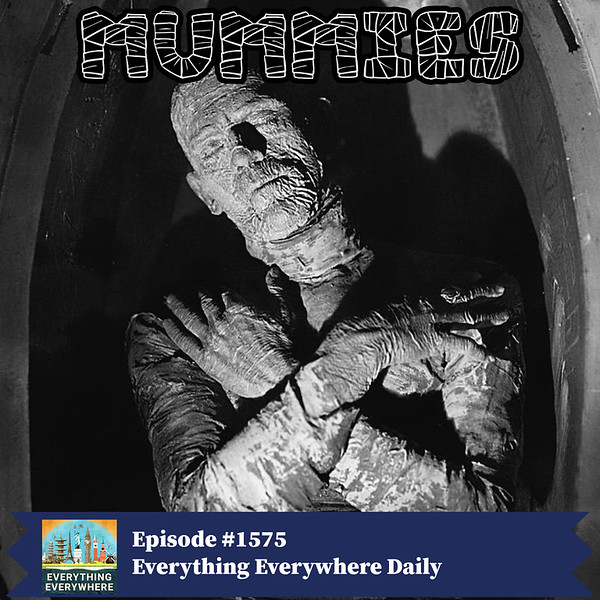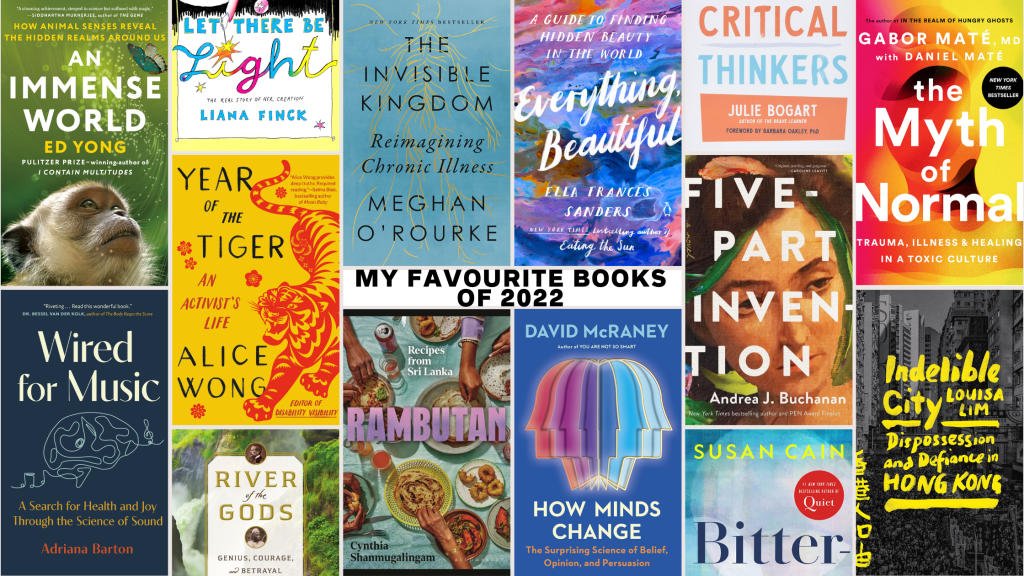Subscribe
Apple | Spotify | Amazon | iHeart Radio | Player.FM | TuneIn
Castbox | Podurama | Podcast Republic | RSS | Patreon
Podcast Transcript
One of the primary religious practices of the Ancient Egyptians was preparing physical bodies for the journey to the afterlife. This highly developed process, perfected over centuries, preserved bodies for thousands of years.
Many of these bodies, discovered by archeologists and thieves, were taken out of Egypt and put in museums all over the world.
They have caught the public’s attention and have been the inspiration for many horror stories.
Learn more about mummies, why they were made, how they were created, and their perception in popular culture on this episode of Everything Everywhere Daily.
While we don’t know everything about Ancient Egypt, we know much more about them than we do other ancient cultures simply because of how much they left behind.
In addition to enormous engineering projects like the pyramids and the temple of Karnak, they literally buried thousands if not millions of artifacts that were used in their everyday life.
It’s actually better. They didn’t just leave artifacts; they left behind the actual preserved bodies of many of their greatest leaders. We know the many ailments that their pharaohs had, for example.
We have been able to conduct genetic tests on the Egyptian mummies that have been discovered, and we have learned far more than we ever could have from hieroglyphics.
Egypt was not the only civilization that practiced embalming. There are examples found in Peru, China, and elsewhere. The Egyptians, however, did it better than anyone else.
Of course, the first question is, why did they do this? An enormous amount of time and effort was put into tombs and embalming. Certainly, they could have done what many cultures did and just dug a hole or built a bonfire.
The practice of embalming in Egypt was rooted in religious beliefs about the afterlife.
The Egyptians believed that the human soul had multiple parts, each playing a distinct role in the afterlife journey.
The “ka” was the life force, or vital essence, that separated from the body upon death. It was believed to need nourishment, hence the practice of leaving food and offerings in tombs.
The “ba” was the part of the soul representing personality and individuality. Unlike the ka, the ba was mobile, allowing it to travel between the world of the living and the dead. In the afterlife, it could reunite with the body each night.
The “akh” was the aspect of the soul associated with divine presence. After successful judgment, it transformed the deceased into an “akh,” or an effective spirit that could enter the eternal afterlife and dwell among the gods.
For the deceased to transition fully into the afterlife, all parts of the soul needed a preserved physical body to recognize and return to each night. Thus, Egyptians placed great emphasis on maintaining the body’s integrity, ensuring the soul’s ongoing existence.
This need for a physical form was very different from that of most ancient cultures, which believed that the soul left the body immediately after death. This is why the Romans, for example, would often just cremate the dead because they didn’t think that the body mattered anymore after death.
The Egyptians believed that after you died you went on a journey. The ultimate goal was to reach the Field of Reeds, an idyllic, fertile land where the deceased could enjoy an eternal existence, free from the struggles of earthly life.
The first step was to place the deceased in a tomb with various grave goods—food, clothing, and amulets—which would serve them in the afterlife. The tomb itself symbolized the home of the dead, reflecting an idealized life to come.
After burial, the deceased had to undergo the weighing of the heart against the feather of Ma’at, the goddess of truth and justice. If the heart was lighter than the feather, symbolizing a virtuous life, the deceased was granted access to the Field of Reeds
If the heart was heavier, it was devoured by the creature Ammit, resulting in the soul’s destruction. Ammit was a god who was one-third crocodile, one-third lion, and one-third hippopotamus.
So, how exactly did Egyptians embalm bodies, and how did they figure out how to do it?
The earliest forms of body preservation were accidental and simple. Bodies buried in Egypt’s dry sand were naturally preserved by desiccation. These early burials led Egyptians to understand the desert’s preservative properties, which laid the foundation for intentional mummification practices.
By the time of the Old Kingdom, about 2700 BC, Egyptians began experimenting with artificial mummification methods. This period marked the first steps toward more intentional embalming techniques, but preservation was still relatively primitive compared to later standards.
Bodies were usually wrapped in linen and sometimes coated in resin or covered in bitumen, a naturally occurring tar-like substance. Internal organs were sometimes removed, though the technique was not yet perfected. Over time, priests began to refine their methods and developed a more systematic approach to embalming.
The Middle Kingdom, about 2050–1650 BC, saw improvements in mummification, with an increased understanding of anatomy. Embalmers started removing internal organs more routinely and preserving them separately in “canopic jars,” dedicated to the gods who would protect them.
The New Kingdom, approximately 1550 to 1070 BC, was the golden age of mummification. It was during this period that embalmers perfected the techniques most associated with Egyptian mummies:
The removal of internal organs became standard practice. The stomach, intestines, lungs, and liver were removed and placed in canopic jars. However, the heart was often left in place as it was believed to be essential for judgment in the afterlife.
One thing that was not considered essential was the brain, which was typically removed and discarded. Embalmers used a hook-like tool inserted through the nostrils to liquefy and extract the brain tissue, a process known as excerebration.
Once removed, the cranial cavity was often filled with resin or linen to help maintain the skull’s shape.
Natron, a naturally occurring salt compound, was essential for desiccating the body. The body was packed in natron for about 40 days, which effectively dried it out and preserved the skin and tissue.
After drying, the body was carefully wrapped in layers of linen, with amulets and charms placed between the layers for protection.
During the Greco-Roman Period, after Alexander the Great’s conquest of Egypt, Egyptian embalming traditions continued but gradually declined in quality as Greek and Roman influences altered the religious and cultural landscape. While mummification remained widespread, techniques were simplified, and bodies were not preserved as skillfully as they had been during the New Kingdom.
The Roman conquest and the eventual adoption of Christianity led to a decline in mummification. By the fourth century CE, it had been largely abandoned and replaced by Christian burial practices.
For centuries, people were aware that Egyptians embalmed their dead, but it wasn’t something that was a field of study or grabbed anyone’s attention.
Certainly, no one associated Egyptian mummies with monsters.
Interest in Egyptian mummification was rekindled in Europe during the 18th and 19th centuries, leading to widespread “mummy unwrapping parties” in Victorian England.
Mummies were seen as curiosities and often destroyed in the process of investigation. As archaeology became more scientific, mummies were studied with greater respect, leading to important discoveries about ancient Egyptian culture, health, and religion.
In the early 20th century, pulp fiction writers found inspiration in the myth of the mummy’s curse and began creating stories about vengeful mummies. For example, Arthur Conan Doyle, famous for his Sherlock Holmes stories, wrote a mummy-themed short story in 1890 called The Ring of Thoth, which features a mummy returning to life. Doyle’s work influenced other writers to explore the concept of reanimated mummies as supernatural threats.
These stories helped shape a narrative where mummies were not just ancient relics but beings with a supernatural essence, capable of resurrecting to haunt and curse those who disturbed their rest.
In 1922, British archaeologist Howard Carter discovered the tomb of Tutankhamu, leading to unprecedented public interest in ancient Egypt. The sudden deaths and misfortunes of some of the people associated with the tomb fueled rumors of an actual “curse of the pharaohs,” suggesting that anyone who disturbed the mummy’s tomb would face a vengeful spirit.
Although the media exaggerated such stories, they sparked public fascination with the idea of cursed mummies and supernatural retribution. News articles and fiction alike began to speculate that ancient mummies could possess magical powers, setting the stage for horror tales.
The 1932 movie The Mummy, starring Boris Karloff, catapulted mummies into the popular imagination. Karloff played Imhotep, an ancient Egyptian priest who is accidentally resurrected and wreaks havoc in his quest to reunite with his lost love.
This film combined the allure of ancient Egypt with horror, portraying the mummy as a reanimated corpse and a tragic, cursed figure seeking vengeance.
The film was a box office success but not a critical one. It was successful enough to spawn a series of sequels. Technically, there were no direct sequels to The Mummy, so the films that came after were simply Mummy themes. These films include the 1940s The Mummy’s Hand and its sequels, 1942s The Mummy’s Tomb, 1944s The Mummy’s Ghost and The Mummy’s Curse, and the studio’s comedy–horror crossover film, 1955s Abbott and Costello Meet the Mummy.
In the mid-20th century, mummies also became subjects of parody. They appeared in humorous roles in cartoons like Scooby-Doo and Casper the Friendly Ghost, where mummies were portrayed as both frightening and funny.
The 1932 film was rebooted in the 1999 film The Mummy starring Brendan Fraser.
This film led to two sequels and a spin-off, the Scorpion King, which also had multiple sequels.
We also can’t forget the 2006 comedy Night at the Museum, whose central plot point is about a mummy that comes to life.
One of the things that keeps this fictional version of mummies alive is that dressing up as a mummy is one of the easiest costumes to make for Halloween. Just get a couple of rolls of toilet paper, and you will be good to go.
Some of you might be wondering, if a fictional mummy is a body that comes back to life, then aren’t mummies just a subset of zombie fiction?
If you were to create a taxonomy of monsters, then it would be reasonable to put mummies and zombies in the same branch. However, there are several major differences between how the zombie archetype has developed compared to the mummy archetype.
Mummy stories usually just involve a single mummy. The mummy has agency, a name, and often has supernatural powers.
Zombies are usually just a mass of unnamed undead who show no personal agency.
Being a mummy can’t be transmitted. Being a zombie usually can.
Mummies are still intimately tied to ancient Egypt, whereas zombies have been all but removed from their original Haitian roots.
Finally, zombie stories tend to be about the end of the world and the destruction of civilization. Mummy stories are usually about the mummy’s curse and a few protagonists.
What mummies and zombies do have in common is that the popular notion of the more stems from single movies. 1932’s The Mummy and 1968’s Night of the Living Dead.
While mummies in Egyptian culture were venerated and preserved for spiritual reasons, they became reimagined in the Western world as cursed entities. This reinterpretation turned them from ancient artifacts into some of the most recognizable monsters in horror.



